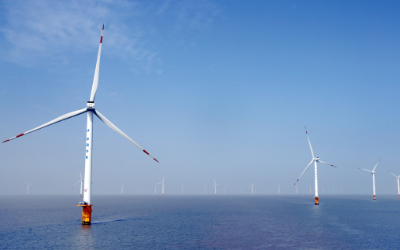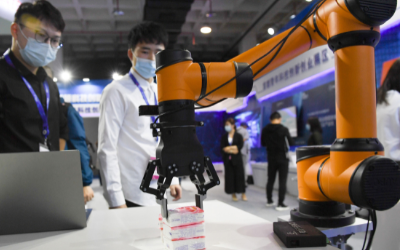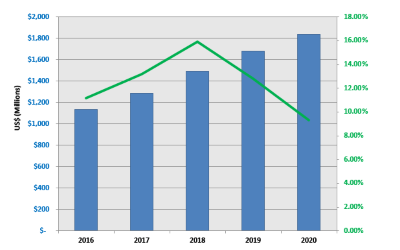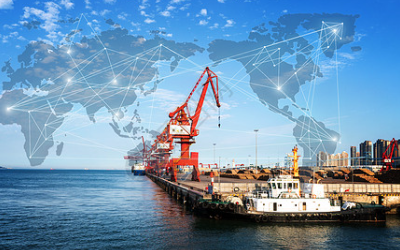Marine economy gaining momentum
In 2001, the total output value of China's marine industry was less than RMB 1 trillion Yuan; in 2011, the number reached 4.56 trillion Yuan, an average annual growth of 16.7 percent, significantly higher than the growth of the GDP. Currently, China's total marine output value accounts for 9.7 percent of the GDP, making it a new growth engine for the national economy.
Thriving industry
Propelled by governments of all levels, China's marine economy has been on a path of rapid development and continuous growth in the past decade. The industry has developed from its early form that centered on marine fishing industry and marine salt industry into a rather complete industrial system that is led by transport, coastal tourism, marine oil and gas, and shipbuilding and substantially supported by emerging industries such as marine power industry, water utilization, marine biomedicine, and marine technology education service.
China's traditional marine industries continue to make progress. Its ocean shipping capacity continue to improve, with more than 20 ports that have a shipping capacity of over 100 million tons and ranking first in the world for seven years in a row in terms of cargo throughput. China has become one of the biggest producers of marine oil and gas in the world -- in 2010, production of marine gas and oil, for the first time, exceeded 50 million ton oil equivalent, which makes it a "Daqing on the sea". China's shipbuilding capability has improved on all levels: in 2011, the completion quantity, the quantity of orders in process, and the quantity of new orders all ranked first in the world. Marine aquaculture capacity and distance water fishing capacity have improved significantly, and the processing and exporting capability of marine aquatic products has been growing unceasingly.
Marine strategic emerging industries that are supported by marine high technologies have been developing rapidly at an average annual rate of more than 20 percent, making it the biggest highlight in the reform of China's marine economy or even the Chinese economy as a whole. In 2011, the added value of the sea water utilization industry was about RMB 1 billion Yuan, double that in the early Eleventh Five-year Plan; the added value of the marine renewable energy industry was nearly RMB 4.9 billion Yuan, more than 10 times that in the early Eleventh Five-year Plan. Besides, the development of a number of new industrial forms, such as cruise ship, yacht, recreational fishing, marine culture, and marine-related financing and shipping industry, has accelerated.
Considerably higher capability
In May 2011, the sixth generation deepwater semi-submersible drilling rig "Hai Yang Shi You 981", the first of its kind designed and manufactured in China, succeeded in reaching a depth of 1,500 meters in the South China Sea, greatly expanding the depth and extent of China's marine resources exploitation and utilization.
The environment and resources reserve in China's inshore areas have basically been figured out. Since 2003, China has conducted a comprehensive marine survey that involves the largest investment, the biggest number of participating organizations and disciplines, and the latest technologies since the founding of the People's Republic of China, having completed such specialized surveys as island coastal zone, maritime space, water body, seabed, and basic social and economic conditions in the coastal areas, basically figured out China's inshore environment and reserve, and constructed a basic framework for digital ocean. Now, the "908 Program" has been successfully completed and a large number of program achievements have been widely applied in numerous fields, providing large volume of fundamental statistics for decision making.
Breakthroughs have been made in all aspects of marine technologies. Offshore wind power generation technologies are being commercialized, with offshore wind farms of more than 10,000 KW being constructed; and China's tidal power generation technology are among the most advanced in the world. Breakthroughs have been made in sea water circulation cooling technology and sea water direct utilization technology, and these technologies have been put into use; potassium, bromine, and magnesium extraction technologies are in the testing phase for industrial application, and a rudimental industrial technology chain system of sea water "direct utilization-desalination-chemical resources extraction" has been established. A number of key technology difficulties have been solved in the R&D of marine biomedicine, marine aquatic products processing and quality safety control, and research in marine biological functional genes has made it into the advanced rank in the world. Great progress has been made in the exploitation and development technology of marine oil and gas and marine gas hydrate, a number of key difficulties have been tackled, and deep-ocean oil and gas exploitation technologies such as submarine seismograph and high-precision seismic acquisition and processing have been developed.
China is developing and using its marine resources in all aspects, from offshore wind power generation to sea water utilization, and from marine life to marine minerals, further deepening the development of China's marine enterprise. Meanwhile, China is also going from coastal waters to high seas, and from oceans to the poles, going deeper into the ocean and further into the polar regions, exhibiting the extent of the development of China's marine enterprise.
In the past ten years, "Jiaolong" has gone into the ocean, completing tests at 1,000 meters, 3,000 meters, 5,000 meters, and 7,000 meters, creating one after another new record for China's manned deep diving enterprise and putting China's mark into the depth of the oceans. In June this year, "Jiaolong", reaching a depth of 7,062 meters, created the deepest diving record of similar working submersibles in the world, indicating that China's manned deep diving technology has entered the advanced rank in the world.
In the past ten years, China has completed 5 oceanic investigation missions, operated for more than 1,200 days offshore, and carried out comprehensive investigations about polymetallic sulfide, cobalt bearing crust, polymetallic nodule, deep-ocean biological genes, and oceanic environment, obtaining a large volume of investigation data and real materials. After obtaining a polymetallic nodule exploitation contract area of more than 75,000 square kilometer in eastern Pacific in 2001, China obtained a polymetallic sulfide mining area of 10,000 square kilometer with exclusive exploration right and mining priority in the international seabed in southwestern Indian Ocean in 2011.
In the past ten years, China's polar region investigation enterprise has achieved leap-forward development, having established the Yellow River Station in the Arctic and the Kunlun Station in the Antarctic, greatly improving logistics support capability in the polar regions and making numerous breakthroughs in polar region investigation and research. In 2009, China's first Antarctic inland investigation station Kunlun Station was established at the top of the Antarctic icecap at an altitude of more than 4,000 meters, historically moving Antarctic investigation from the border of the Antarctic mainland into the Antarctic hinterland. In 2010, the North Pole was reached for the first time in the fourth Arctic investigation.
Propelled by governments of all levels, China's marine economy has been on a path of rapid development and continuous growth in the past decade. The industry has developed from its early form that centered on marine fishing industry and marine salt industry into a rather complete industrial system that is led by transport, coastal tourism, marine oil and gas, and shipbuilding and substantially supported by emerging industries such as marine power industry, water utilization, marine biomedicine, and marine technology education service.
China's traditional marine industries continue to make progress. Its ocean shipping capacity continue to improve, with more than 20 ports that have a shipping capacity of over 100 million tons and ranking first in the world for seven years in a row in terms of cargo throughput. China has become one of the biggest producers of marine oil and gas in the world -- in 2010, production of marine gas and oil, for the first time, exceeded 50 million ton oil equivalent, which makes it a "Daqing on the sea". China's shipbuilding capability has improved on all levels: in 2011, the completion quantity, the quantity of orders in process, and the quantity of new orders all ranked first in the world. Marine aquaculture capacity and distance water fishing capacity have improved significantly, and the processing and exporting capability of marine aquatic products has been growing unceasingly.
Marine strategic emerging industries that are supported by marine high technologies have been developing rapidly at an average annual rate of more than 20 percent, making it the biggest highlight in the reform of China's marine economy or even the Chinese economy as a whole. In 2011, the added value of the sea water utilization industry was about RMB 1 billion Yuan, double that in the early Eleventh Five-year Plan; the added value of the marine renewable energy industry was nearly RMB 4.9 billion Yuan, more than 10 times that in the early Eleventh Five-year Plan. Besides, the development of a number of new industrial forms, such as cruise ship, yacht, recreational fishing, marine culture, and marine-related financing and shipping industry, has accelerated.
Considerably higher capability
In May 2011, the sixth generation deepwater semi-submersible drilling rig "Hai Yang Shi You 981", the first of its kind designed and manufactured in China, succeeded in reaching a depth of 1,500 meters in the South China Sea, greatly expanding the depth and extent of China's marine resources exploitation and utilization.
The environment and resources reserve in China's inshore areas have basically been figured out. Since 2003, China has conducted a comprehensive marine survey that involves the largest investment, the biggest number of participating organizations and disciplines, and the latest technologies since the founding of the People's Republic of China, having completed such specialized surveys as island coastal zone, maritime space, water body, seabed, and basic social and economic conditions in the coastal areas, basically figured out China's inshore environment and reserve, and constructed a basic framework for digital ocean. Now, the "908 Program" has been successfully completed and a large number of program achievements have been widely applied in numerous fields, providing large volume of fundamental statistics for decision making.
Breakthroughs have been made in all aspects of marine technologies. Offshore wind power generation technologies are being commercialized, with offshore wind farms of more than 10,000 KW being constructed; and China's tidal power generation technology are among the most advanced in the world. Breakthroughs have been made in sea water circulation cooling technology and sea water direct utilization technology, and these technologies have been put into use; potassium, bromine, and magnesium extraction technologies are in the testing phase for industrial application, and a rudimental industrial technology chain system of sea water "direct utilization-desalination-chemical resources extraction" has been established. A number of key technology difficulties have been solved in the R&D of marine biomedicine, marine aquatic products processing and quality safety control, and research in marine biological functional genes has made it into the advanced rank in the world. Great progress has been made in the exploitation and development technology of marine oil and gas and marine gas hydrate, a number of key difficulties have been tackled, and deep-ocean oil and gas exploitation technologies such as submarine seismograph and high-precision seismic acquisition and processing have been developed.
China is developing and using its marine resources in all aspects, from offshore wind power generation to sea water utilization, and from marine life to marine minerals, further deepening the development of China's marine enterprise. Meanwhile, China is also going from coastal waters to high seas, and from oceans to the poles, going deeper into the ocean and further into the polar regions, exhibiting the extent of the development of China's marine enterprise.
In the past ten years, "Jiaolong" has gone into the ocean, completing tests at 1,000 meters, 3,000 meters, 5,000 meters, and 7,000 meters, creating one after another new record for China's manned deep diving enterprise and putting China's mark into the depth of the oceans. In June this year, "Jiaolong", reaching a depth of 7,062 meters, created the deepest diving record of similar working submersibles in the world, indicating that China's manned deep diving technology has entered the advanced rank in the world.
In the past ten years, China has completed 5 oceanic investigation missions, operated for more than 1,200 days offshore, and carried out comprehensive investigations about polymetallic sulfide, cobalt bearing crust, polymetallic nodule, deep-ocean biological genes, and oceanic environment, obtaining a large volume of investigation data and real materials. After obtaining a polymetallic nodule exploitation contract area of more than 75,000 square kilometer in eastern Pacific in 2001, China obtained a polymetallic sulfide mining area of 10,000 square kilometer with exclusive exploration right and mining priority in the international seabed in southwestern Indian Ocean in 2011.
In the past ten years, China's polar region investigation enterprise has achieved leap-forward development, having established the Yellow River Station in the Arctic and the Kunlun Station in the Antarctic, greatly improving logistics support capability in the polar regions and making numerous breakthroughs in polar region investigation and research. In 2009, China's first Antarctic inland investigation station Kunlun Station was established at the top of the Antarctic icecap at an altitude of more than 4,000 meters, historically moving Antarctic investigation from the border of the Antarctic mainland into the Antarctic hinterland. In 2010, the North Pole was reached for the first time in the fourth Arctic investigation.








